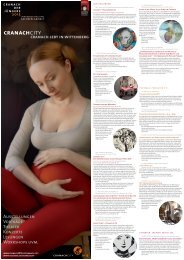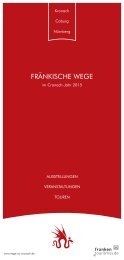In the Footsteps of Cranach - A Journey of Discovery
Twelve German towns and cities have come together in the 'Routes to Cranach' project to bring the life and works of the renowned Renaissance artist Lucas Cranach to the widest audience.
Twelve German towns and cities have come together in the 'Routes to Cranach' project to bring the life and works of the renowned Renaissance artist Lucas Cranach to the widest audience.
Create successful ePaper yourself
Turn your PDF publications into a flip-book with our unique Google optimized e-Paper software.
3<br />
Where <strong>the</strong> <strong>Cranach</strong>s made <strong>the</strong> acquaintance<br />
<strong>of</strong> Albrecht Dürer<br />
Nuremberg<br />
The Imperial Diet <strong>of</strong> 1524 brought Lucas <strong>Cranach</strong><br />
<strong>the</strong> Elder to Nuremberg at <strong>the</strong> behest <strong>of</strong> his patron Elector<br />
Frederick <strong>the</strong> Wise, and it was here that he met Albrecht<br />
Dürer. This meeting also yielded <strong>the</strong> famous silverpoint<br />
portrait <strong>of</strong> <strong>Cranach</strong> (Bayonne). However, because <strong>of</strong> <strong>the</strong><br />
similarity <strong>of</strong> <strong>Cranach</strong>’s early artistic style to that <strong>of</strong> Dürer,<br />
historians suspect he had been to Nuremberg and worked<br />
at Dürer’s workshop prior to his appointment to <strong>the</strong> royal<br />
court <strong>of</strong> Saxony.<br />
<strong>In</strong> Nuremberg in 1508, Elector Frederick <strong>the</strong> Wise<br />
granted <strong>Cranach</strong> a coat <strong>of</strong> arms depicting a serpent, which<br />
<strong>the</strong> painter used as his signature from <strong>the</strong>n on.<br />
Today, <strong>the</strong> Germanic National Museum houses an<br />
extensive collection <strong>of</strong> important works by <strong>Cranach</strong>. Lucas<br />
<strong>Cranach</strong> <strong>the</strong> Elder played a defining role in German art from<br />
1500 to 1550 and his works are among <strong>the</strong> highlights <strong>of</strong> <strong>the</strong><br />
museum’s Renaissance, Baroque, Enlightenment exhibition.<br />
A particular focus <strong>of</strong> <strong>the</strong> exhibition is <strong>the</strong> sea change in<br />
<strong>the</strong>ological thinking and <strong>the</strong> radical transformation in <strong>the</strong><br />
way images were used and understood. Paintings depicting<br />
<strong>the</strong> plague and <strong>the</strong> sale <strong>of</strong> indulgences illustrate a religious<br />
practice that had become established over centuries. <strong>In</strong><br />
contrast, Protestant allegories such as <strong>Cranach</strong>’s panel Law<br />
and Gospel attest to a new understanding <strong>of</strong> religion. Objects<br />
such as Lu<strong>the</strong>r’s cup or <strong>the</strong> venerated “piece <strong>of</strong> fabric from<br />
Dr. Martin Lu<strong>the</strong>r’s robe” show how Lu<strong>the</strong>r became part<br />
<strong>of</strong> <strong>the</strong> cult <strong>of</strong> saints and relics after his death, something<br />
that he had fought against all his life.<br />
<strong>Cranach</strong> <strong>the</strong> Elder is represented in <strong>the</strong> sections <strong>of</strong><br />
<strong>the</strong> exhibition on Imagery and <strong>the</strong> Reformation, Lu<strong>the</strong>r,<br />
Old<br />
and New Teachings and The Power <strong>of</strong> Beauty. On display are







